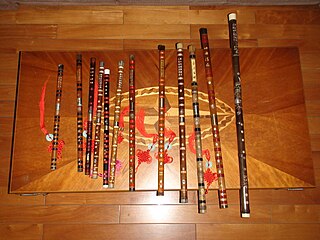
Bagpipes are a woodwind instrument using enclosed reeds fed from a constant reservoir of air in the form of a bag. The Great Highland bagpipes are well known, but people have played bagpipes for centuries throughout large parts of Europe, Northern Africa, Western Asia, around the Persian Gulf and northern parts of South Asia.

Music is generally defined as the art of arranging sound to create some combination of form, harmony, melody, rhythm or otherwise expressive content. Exact definitions of music vary considerably around the world, though it is an aspect of all human societies, a cultural universal. While scholars agree that music is defined by a few specific elements, there is no consensus on their precise definitions. The creation of music is commonly divided into musical composition, musical improvisation, and musical performance, though the topic itself extends into academic disciplines, criticism, philosophy, and psychology. Music may be performed or improvised using a vast range of instruments, including the human voice.

The tin whistle, also called the penny whistle, is a simple six-holed woodwind instrument. It is a type of fipple flute, putting it in the same class as the recorder, Native American flute, and other woodwind instruments that meet such criteria. A tin whistle player is called a whistler. The tin whistle is closely associated with Irish traditional music and Celtic music. Other names for the instrument are the flageolet, English flageolet, Scottish penny whistle, tin flageolet, or Irish whistle.
In music, ornaments or embellishments are musical flourishes—typically, added notes—that are not essential to carry the overall line of the melody, but serve instead to decorate or "ornament" that line, provide added interest and variety, and give the performer the opportunity to add expressiveness to a song or piece. Many ornaments are performed as "fast notes" around a central, main note.

The uilleann pipes are the characteristic national bagpipe of Ireland. Earlier known in English as "union pipes", their current name is a partial translation of the Irish language terms píobaí uilleann, from their method of inflation. There is no historical record of the name or use of the term uilleann pipes before the 20th century. It was an invention of Grattan Flood and the name stuck. People mistook the term 'union' to refer to the 1800 Act of Union; this is incorrect as Breandán Breathnach points out that a poem published in 1796 uses the term 'union'.

The Great Highland bagpipe is a type of bagpipe native to Scotland, and the Scottish analogue to the Great Irish Warpipes. It has acquired widespread recognition through its usage in the British military and in pipe bands throughout the world.

Like the surrounding Balkan countries, Bosnia and Herzegovina has had a turbulent past marked by frequent foreign invasions and occupation. As a result, Bosnian music is now a mixture of Slavic, Turkish, Central European, Mediterranean, and other influences.
Northwest Iberian folk music is a traditional highly distinctive folk style, located along Spain's north-west Atlantic coast, mostly Galicia and Asturias, that has some similarities with the neighbouring area of Cantabria. The music is characterized by the use of bagpipes.

The dizi, is a Chinese transverse flute. It is also sometimes known as the di or héngdi, and has varieties including Qudi, Bangdi, and Xindi. It is a major Chinese musical instrument that is widely used in many genres of Chinese folk music, Chinese opera, as well as the modern Chinese orchestra. The dizi is also a popular instrument among the Chinese people as it is simple to make and easy to carry.

The guqin is a plucked seven-string Chinese musical instrument. It has been played since ancient times, and has traditionally been favoured by scholars and literati as an instrument of great subtlety and refinement, as highlighted by the quote "a gentleman does not part with his qin or se without good reason," as well as being associated with the ancient Chinese philosopher Confucius. It is sometimes referred to by the Chinese as "the father of Chinese music" or "the instrument of the sages". The guqin is not to be confused with the guzheng, another Chinese long stringed instrument also without frets, but with moveable bridges under each string.
In music, a drone is a harmonic or monophonic effect or accompaniment where a note or chord is continuously sounded throughout most or all of a piece. A drone may also be any part of a musical instrument used to produce this effect; an archaic term for this is burden such as a "drone [pipe] of a bagpipe", the pedal point in an organ, or the lowest course of a lute. Α burden is also part of a song that is repeated at the end of each stanza, such as the chorus or refrain.

A pub session is performing music in the setting of a local pub, in which the music-making is intermingled with the consumption of ale, stout, and beer and conversation. Performers sing and play traditional songs and tunes from the Irish, English, Scottish and Manx traditions, using instruments such as the fiddle, accordion, concertina, flute, tin whistle, uilleann pipes, tenor banjo, guitar, and bodhrán. Some sessions have dancing too

The music of the southern China has many features that are distinct from the rest of the country. For instance, many folk songs only use three notes. The region is home to significant populations of ethnic minorities, such as the Zhuang, Miao, She and Tai peoples.
The Butterfly Lovers' Violin Concerto, along with the Yellow River Piano Concerto, is one of the most famous Chinese works of orchestral music. It is an adaptation of an ancient legend, the Butterfly Lovers. Written for a Western-style orchestra, it features a solo violin played using some Chinese techniques.

Nanguan is a style of Chinese classical music from the southern Chinese province of Fujian. It is also popular in Taiwan, particularly Lukang on west coast, as well as among Overseas Chinese in Southeast Asia.

The musette de cour or baroque musette is a musical instrument of the bagpipe family. Visually, the musette is characterised by the short, cylindrical shuttle-drone and the two chalumeaux. Both the chanters and the drones have a cylindrical bore and use a double reed, giving a quiet tone similar to the oboe. The instrument is blown by a bellows.
Non-religious secular music and sacred music were the two main genres of Western music during the Middle Ages and Renaissance era. The oldest written examples of secular music are songs with Latin lyrics. However, many secular songs were sung in the vernacular language, unlike the sacred songs that followed the Latin language of the Church. These earliest types were known as the chanson de geste and were popular amongst the traveling jongleurs and minstrels of the time.
Jiangnan sizhu is a style of traditional Chinese instrumental music from the Jiangnan region of China.

Irish traditional music is a genre of folk music that developed in Ireland.
Kui Dong is a Chinese-American composer, musician, and teacher. She is known for her music which has often incorporated traditional Chinese music into contemporary contexts, and is currently Professor of Music at Dartmouth College. She has released two albums on the Other Minds record label: Hands Like Waves Unfold (2008) and Since When Has the Bright Moon Existed? (2011).












